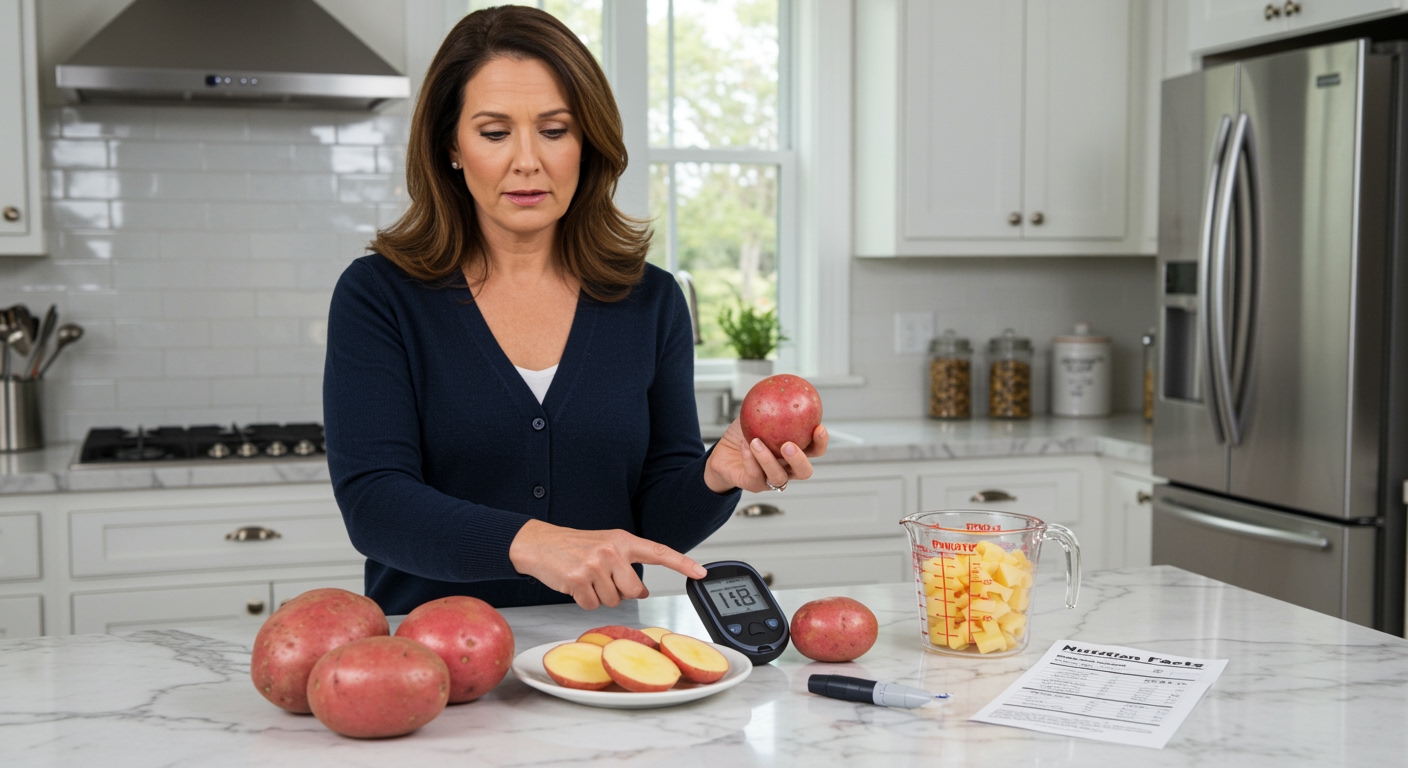✪ Key Takeaway: Red potatoes can be part of a diabetes meal plan when eaten in controlled portions and paired with protein or healthy fats.
Introduction
You stare at that beautiful red potato in your kitchen and wonder if it will spike your blood sugar through the roof.
This question haunts many people with diabetes because potatoes have earned a reputation as blood sugar villains that should be completely avoided.
Hi, I’m Abdur, your nutrition coach and today I’m going to explain exactly how red potatoes affect your blood sugar and whether they deserve a place on your diabetes-friendly plate.
How Do Red Potatoes Affect Blood Sugar?
Red potatoes contain carbohydrates that your body breaks down into glucose, which directly impacts your blood sugar levels.
A medium red potato weighing about 150 grams contains approximately 26 grams of carbohydrates, which is significant for blood sugar management.
The glycemic index of red potatoes ranges from 62 to 78, depending on the cooking method, which places them in the medium to high category.
When you eat red potatoes, your digestive system converts their starch into glucose within 30 to 60 minutes after consumption.
This glucose enters your bloodstream and triggers your pancreas to release insulin to help cells absorb the sugar for energy.
However, people with diabetes either do not produce enough insulin or their cells resist insulin action, leading to elevated blood glucose levels.
The cooking method significantly influences how quickly red potatoes raise blood sugar, with boiled potatoes having a lower glycemic response than baked or fried versions.
✪ Fact: Cooling cooked red potatoes increases resistant starch content, which lowers their blood sugar impact.
What Makes Red Potatoes Different From Other Potatoes?
Red potatoes have a waxy texture and thinner skin compared to russet or white potatoes, which affects their nutritional profile.
They contain slightly fewer carbohydrates per serving than russet potatoes, making them a marginally better choice for blood sugar control.
The red skin provides additional antioxidants called anthocyanins, which may help reduce inflammation associated with diabetes complications.
Red potatoes also have a higher moisture content, which can help you feel fuller with smaller portions compared to drier potato varieties.
Their glycemic index tends to be on the lower end of the potato spectrum, especially when prepared properly with the skin intact.
The fiber content in red potato skin helps slow down glucose absorption, providing a more gradual blood sugar rise than peeled potatoes.
✪ Pro Tip: Always eat red potatoes with their skin on to maximize fiber intake and minimize blood sugar spikes.
Can You Include Red Potatoes In A Diabetes Diet?
Yes, you can include red potatoes in a diabetes diet when you follow proper portion control and preparation methods.
The key lies in treating red potatoes as a starch serving rather than a free vegetable, counting them toward your daily carbohydrate allowance.
A reasonable serving size for someone with diabetes is about half a medium red potato, which contains roughly 13 grams of carbohydrates.
Pairing red potatoes with protein and healthy fats helps slow glucose absorption and prevents sharp blood sugar spikes.
For example, eating red potatoes with grilled chicken and olive oil creates a more balanced meal that supports stable blood glucose levels.
The timing of consumption also matters, with red potatoes being better tolerated earlier in the day when your body is more insulin sensitive.
Many diabetes educators recommend using the plate method, where red potatoes occupy no more than one-quarter of your plate alongside non-starchy vegetables and lean protein.
✪ Note: Monitor your individual blood sugar response to red potatoes, as tolerance varies significantly between people.
What Are The Best Ways To Prepare Red Potatoes For Diabetes?
The preparation method dramatically influences how red potatoes affect your blood sugar, making cooking technique crucial for diabetes management.
Boiling red potatoes produces the lowest glycemic response compared to baking, roasting, or frying methods.
Steaming red potatoes with their skin intact preserves nutrients while maintaining a lower impact on blood glucose levels.
Adding vinegar or lemon juice to red potatoes during cooking can help reduce their glycemic index by up to 25 percent.
Letting cooked red potatoes cool completely before eating increases their resistant starch content, which acts more like fiber than regular starch.
Avoid deep-frying or making red potato chips, as these methods dramatically increase both calories and blood sugar impact.
Consider making potato salad with cooled red potatoes, as the resistant starch formation helps moderate glucose absorption while providing satisfying texture and flavor.
✪ Pro Tip: Cook red potatoes the day before and eat them cold to maximize resistant starch benefits for blood sugar control.
The Bottom Line
Red potatoes can absolutely be part of a well-planned diabetes diet when you respect portion sizes and choose smart preparation methods.
The dose makes the poison, and the method makes the medicine – this principle applies perfectly to red potatoes and diabetes management.
I would love to hear about your experiences with red potatoes and blood sugar management, so please share your questions, success stories, or concerns in the comments section below.
References
At NutritionCrown, we use quality and credible sources to ensure our content is accurate and trustworthy. Below are the sources referenced in creating this article:
- PMC: Potato consumption and risk of type 2 diabetes
- Healthline: Potatoes and Diabetes: Safety, Risks, and Alternatives
- Harvard Nutrition Source: Potatoes
- Signos: How Potatoes Affect Blood Sugar





